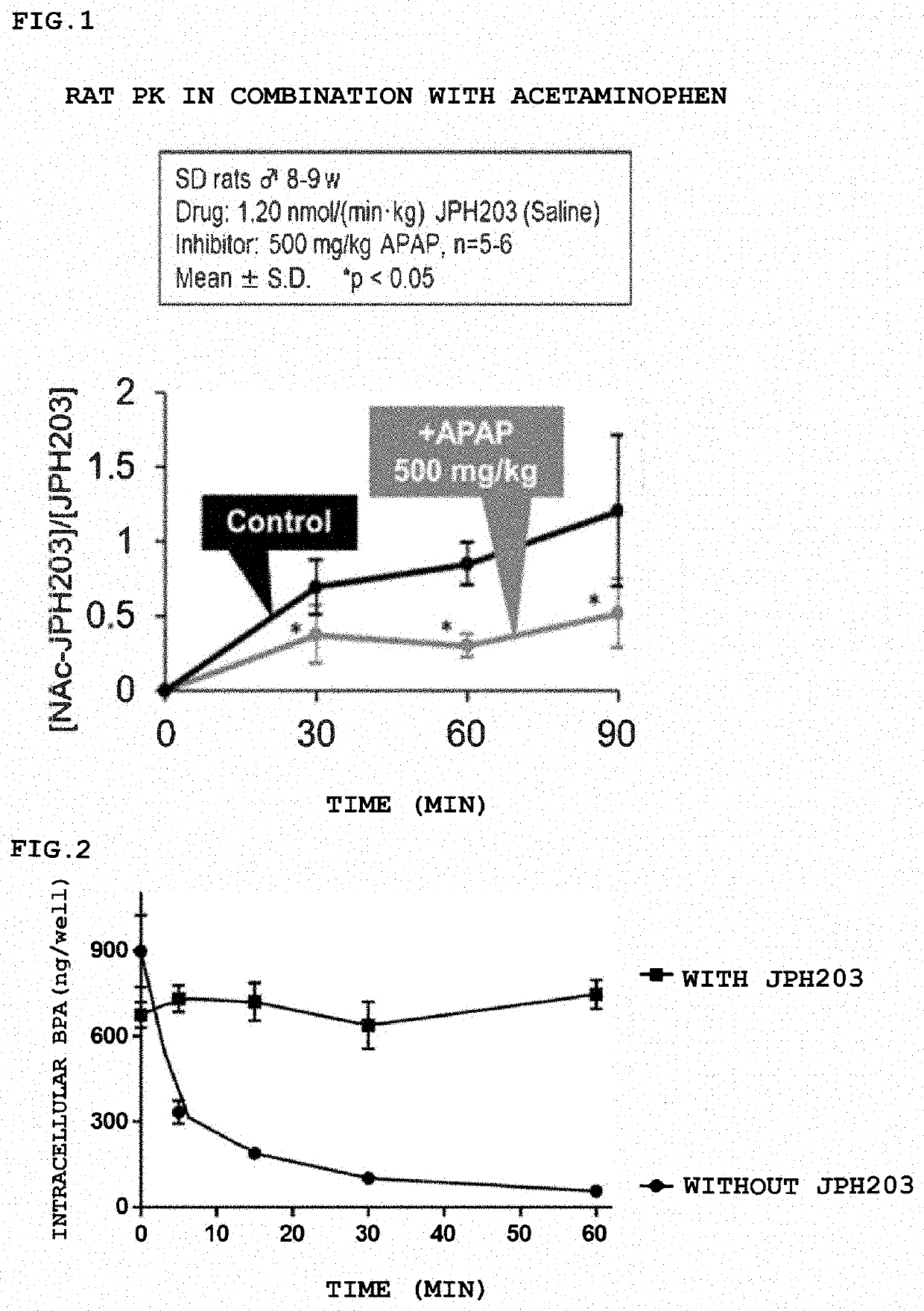A pharmaceutical composition for treating cancer used for a patient having specific genetic marker
a technology of specific genetic markers and pharmaceutical compositions, applied in the field of pharmaceutical compositions, can solve the problems of increasing the clinical need for chemotherapy as secondary therapy, affecting the therapeutic effect and toxicity affecting the safety of many therapeutic agents, so as to improve the effect and enhance the safety of the drug
- Summary
- Abstract
- Description
- Claims
- Application Information
AI Technical Summary
Benefits of technology
Problems solved by technology
Method used
Image
Examples
example 1
[0102]Drug used: JPH203-SBECD (50 mg as an active ingredient) is dissolved in 9.7 ml of water for injection to a concentration of 50 mg / 10 ml, and finally the total volume is 100 ml according to the body surface area of a patient.
[0103]An uncontrolled, open-label, domestic phase I study was conducted to evaluate the safety of JPH203-SBECD (12, 25, 40, 60, 85 mg / m2)and determine the recommended dose in the next phase, and analyze the pharmacokinetics for patients with an advanced-stage solid cancer who are ineffective or intolerant to a standard treatment. The initial dose of the investigational drug was 12 mg / m2, and 5 levels (12, 25, 40, 60, 85 mg / m2) were set to increase the dose according to the modified Fibonacci method. Three subjects enrolled within 28 days of obtaining consent were targeted for in each level, and a single administration was administered within 4 days after enrollment. After the first subject received a single administration, when the results of the pre-dose e...
example 2
[0152]Combination Experiment of JPH203 and NAT2 Inhibitor
[0153]Whether the concentration of JPH203 in the liver in plasma increases or the concentration of its metabolite Nac-JPH203 decreases is evaluated by administration of acetaminophen (APAP), which is a NAT2 inhibitor.
[0154]The animal used was a male SD rat 8 weeks old, and 1.20 nmol / (min / kg) of JPH203 was administered. JPH203 was diluted to the concentration with physiological saline and the rate of administration is 20 μL / min. Acetaminophen (500 and 1500 mg / kg) was administered 30 minutes before administration of JPH203. (0.5% aqueous methylcellulose solution). The time of blood collection was 0 (blank), 30, 60, 120, 180, and 240 minutes after administration of JPH203. The amount of sample to be collected was 0.2 mL for plasma and about 0.4 mL for blood, and the liver, kidney, brain and CSF were collected.
[0155]The results are shown in FIG. 1. The result shows that the combined use of JPH203 and the NAT2 inhibitor significant...
example 3
[0156]A pancreatic cancer-derived cell T3M4 was used as a representative cancer cell, BPA was added to the cell, and 10 μM of JPH203 was added 15 minutes later, and the concentration of BPA contained in the cell was measured. The results are shown in FIG. 2. When JPH203 is not added (●), the intracellular concentration of BPA decreases as it is excreted from the cell over time. On the other hand, when JPH203 is added (▪), it can be seen that the intracellular concentration is maintained because the excretion of BPA is suppressed by JPH203, and the difference in intracellular concentration between the two is about 10 times after 30 minutes.
PUM
| Property | Measurement | Unit |
|---|---|---|
| Time | aaaaa | aaaaa |
| Time | aaaaa | aaaaa |
| Time | aaaaa | aaaaa |
Abstract
Description
Claims
Application Information
 Login to View More
Login to View More - R&D
- Intellectual Property
- Life Sciences
- Materials
- Tech Scout
- Unparalleled Data Quality
- Higher Quality Content
- 60% Fewer Hallucinations
Browse by: Latest US Patents, China's latest patents, Technical Efficacy Thesaurus, Application Domain, Technology Topic, Popular Technical Reports.
© 2025 PatSnap. All rights reserved.Legal|Privacy policy|Modern Slavery Act Transparency Statement|Sitemap|About US| Contact US: help@patsnap.com


